Hooked on Jaffna
Source : sundaytimes
In her travel series Juliet Coombe enjoys the generous spirit of hospitality and jaggery sweet love of life of the north of Sri Lanka
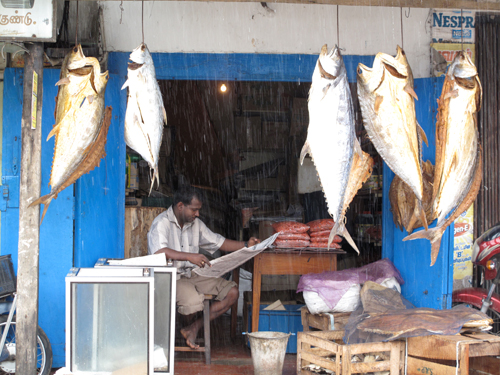
Jaffna Market: Dried fish in the rain. Pix by Juliet Coombe
Jaffna sizzles with spicy food, sparkling sarees in an area surrounded by a dry and arid landscape with floating dunes and palmyrah trees.
Solid cast irons with flat plates are still being employed in the back streets of Jaffna’s old town, with hot coconut coals hissing as they are heated for the day’s ironing in tiny wooden cleaning shops, walking distance from the Jaffna Library and Fort. Vintage cars buzz by, as visitors explore the many fascinating heritage buildings, past meandering cows, schoolkids riding sidesaddle on Singer bikes and colourful three-wheelers.
Here amidst the buzz of daily life, the temples remain unchanged for centuries, acting as the central hub of inner contemplation, with a never ending flow of pilgrims returning from their holy pujas. Jaffna’s cream shops, just outside the temple complex grounds, is where everyone meets up to cool off. So, whether it is post prayer in Nallur temple, after a hard day’s labour or school, or a secret rendezvous, this is the venue to be if you want a sweet time, as these wonderful emporiums of creamy treats include jumbo-sized ice creams covered in sprinkles and Rio specials with wobbly jelly additions.
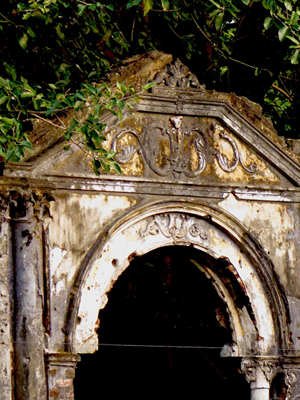
Remains of the Fort: Time locked Jaffna old town
In the old quarter, one can explore the remains of historic buildings, such as the magnificent Jaffna Dutch Fort complex overlooking the lagoon, which is an excellent spot to walk the walls, take pictures and understand the city’s fascinating colonial past. However, to learn about the daily life of the people, head for the local markets, where you will quickly understand why the Northern areas are so very different, with their different types of exotic fruits, vegetables, and their ways to dry fish and make spices.
As you explore the lively bazaars, do try slices of different foods, like jaggery packaged in traditional palmyrah in beautiful shapes from a thimble size – for a few rupees – to large lumps of the coarse dark brown jaggery sugar, sold in giant cup sizes in larger than life glass boxes. This sweeter than sweet sap comes from the palmyrah trees that line up like a welcoming platoon when you come into Jaffna and visit the islands. Whatever is not tapped is turned into attractive fan-like fencing around people’s houses or animal pens.
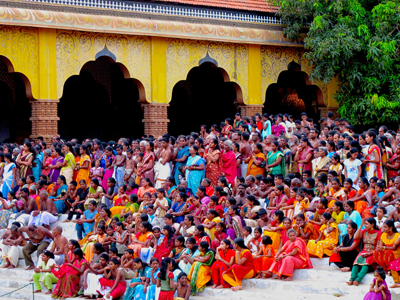
Nallur festival: Attracting pilgrims islandwide
I am told, as I try a piece, that the jaggery is made from a syrup after boiling palm sap in large, shallow, round cooking bowls, to a third of its original consistency. “We know the jaggery is ready when it forms a delicious fermented froth,” explains one of the sellers, as I explore the Jaffna market, only a few minutes’ walk from the centrally located Jetwing Jaffna Hotel, to where you can escape the heat and enjoy a delicious juice and exquisite curry lunch or dinner with fabulous views of the city, and where locally-cooked village homemade dishes are a specialty.
Jaggery is also used annually at Hindu festival time, to celebrate the start of the harvesting season; the pongal, is a mix of rice with sugar cane and Jaffna jaggery, cadju, raisins and cardamom. During this time, rice art is created in front of people’s houses, providing food for ants and other insects. Jaggery, I learn, is also used to make kalhi, to sweeten fruit salads and payasam (sweet milk) offered to the Gods in the kovils, as it has always had a deeply religious significance to the Hindus.
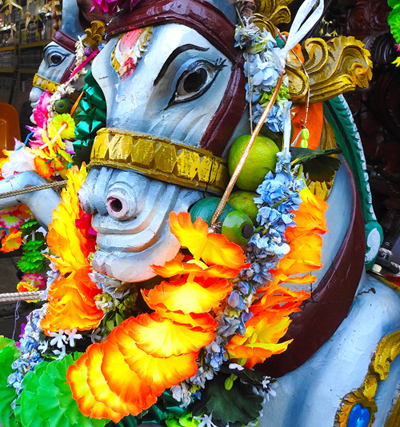
Blaze of colour: Garlanded horse
Jaffna’s central bazaar is also a fun place to explore and discover the joys of Jaffna coffee, a kind of dry Arabic Sri Lankan blend that is bitter, with a nice big wake-up kick to it. Here, you can also handpick woven palmyrah household items like hopper moulds, and try the famous Jaffna mango “karuthakolumban” sweets – in particular bolly, which is made from flour and coconut cream mixed with green gram and sugar.
Jaffna is famous for its own variety of spices and, in particular, a type of fiery chilli powder which is why Jaffna crab curry is so spicy.
The most popular souvenirs are Jaffna cigars, a kind of Cuban Sri Lankan hybrid which, when combined with photographs taken by the classic vintage cars, completes the cool vibe.
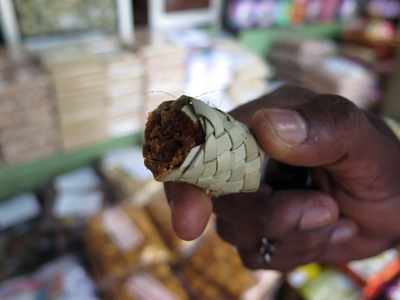
Thimble treat: Palmyrah Jaggery
If you can spend a week in this Northern gem of a town, head to a place called Punkudutivu passing the fishermen sewing nets early morning, only a short distance from where the ferryboats dock to take people to three of Jaffna’s seven low-lying islands, known as the crown jewels of the Indian Ocean. Punkudutivu village is full of beautiful old houses from the colonial period, with hand carved ornate lattice stonework found above the doorways. These include elaborate peacock, elephant and floral designs in stone and wood, painted over in white and, in the case of one house on the main road, there is a regal porch with two elephants flanking it. Amazingly, these elephant sculptures have retained much of their original paintwork and are still holding up the porch and roof with the tip of their trunks. It’s a place where trees grow through abandoned bombed and bullet-sprayed historic buildings,. The elephant house is a gem, just before the town’s church of South India, behind a rickety old driftwood stick-like fence. Otherwise, spend a day in Delft Island and discover the wild horses and yet another style of Northern cuisine.
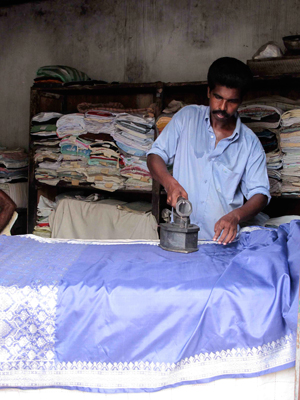
Yesteryear charm: Old fashioned brass iron
Returning to the north’s most hospitable town, you can explore the original Catholic St. John’s Church on Chundikuli Road, a relic from Portuguese times, re-built in 1823 by the Dutch, that surely will make you realise just how diverse and special Jaffna is. Then head to the nearby cricket grounds, where you can join in a game or two with the local kids.
July/August is when Jaffna bursts into life in with the spectacular Nallur festival, with vibrant nightly chariot processions, ritual drumming, traditional dancing and incredible acts of faith, in the form of self-mortification. On the penultimate day, there is a procession of the statue of Lord Murugan, with his two wives, to the sounds of bells ringing, conch blowing, and an orchestra of temple music reverberating around the square. The statues are taken round the inner sanctum to the beat of the melodic drum and then out into the main temple courtyard, where a trail of coconuts litter their pathway. It’s not surprising that this festival is so compelling, like the city itself you quickly become hooked on, its generous spirit of hospitality and jaggery sweet love of life.







